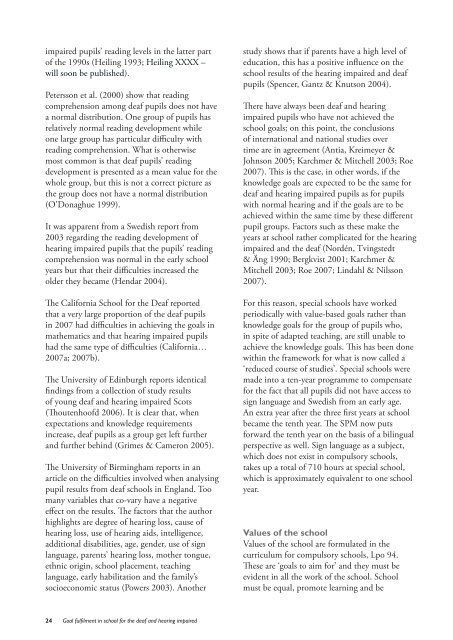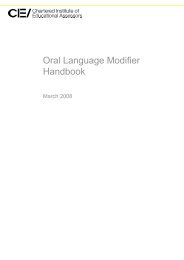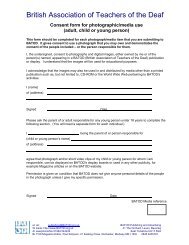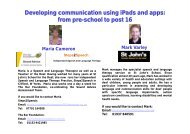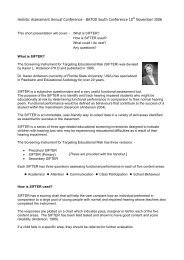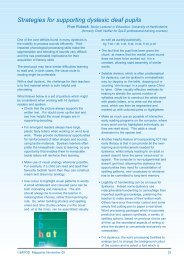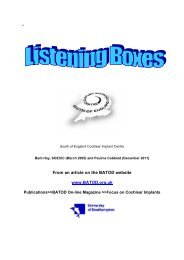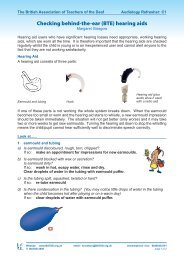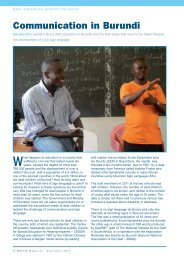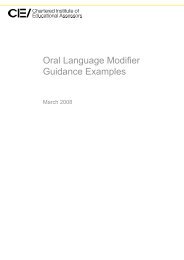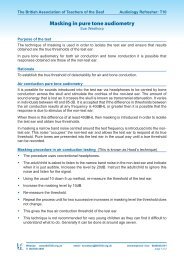Goal fulfilment in school for the deaf and hearing impaired - batod
Goal fulfilment in school for the deaf and hearing impaired - batod
Goal fulfilment in school for the deaf and hearing impaired - batod
- No tags were found...
You also want an ePaper? Increase the reach of your titles
YUMPU automatically turns print PDFs into web optimized ePapers that Google loves.
<strong>impaired</strong> pupils’ read<strong>in</strong>g levels <strong>in</strong> <strong>the</strong> latter partof <strong>the</strong> 1990s (Heil<strong>in</strong>g 1993; Heil<strong>in</strong>g XXXX –will soon be published).Petersson et al. (2000) show that read<strong>in</strong>gcomprehension among <strong>deaf</strong> pupils does not havea normal distribution. One group of pupils hasrelatively normal read<strong>in</strong>g development whileone large group has particular difficulty withread<strong>in</strong>g comprehension. What is o<strong>the</strong>rwisemost common is that <strong>deaf</strong> pupils’ read<strong>in</strong>gdevelopment is presented as a mean value <strong>for</strong> <strong>the</strong>whole group, but this is not a correct picture as<strong>the</strong> group does not have a normal distribution(O’Donaghue 1999).It was apparent from a Swedish report from2003 regard<strong>in</strong>g <strong>the</strong> read<strong>in</strong>g development ofhear<strong>in</strong>g <strong>impaired</strong> pupils that <strong>the</strong> pupils’ read<strong>in</strong>gcomprehension was normal <strong>in</strong> <strong>the</strong> early <strong>school</strong>years but that <strong>the</strong>ir difficulties <strong>in</strong>creased <strong>the</strong>older <strong>the</strong>y became (Hendar 2004).The Cali<strong>for</strong>nia School <strong>for</strong> <strong>the</strong> Deaf reportedthat a very large proportion of <strong>the</strong> <strong>deaf</strong> pupils<strong>in</strong> 2007 had difficulties <strong>in</strong> achiev<strong>in</strong>g <strong>the</strong> goals <strong>in</strong>ma<strong>the</strong>matics <strong>and</strong> that hear<strong>in</strong>g <strong>impaired</strong> pupilshad <strong>the</strong> same type of difficulties (Cali<strong>for</strong>nia…2007a; 2007b).The University of Ed<strong>in</strong>burgh reports identicalf<strong>in</strong>d<strong>in</strong>gs from a collection of study resultsof young <strong>deaf</strong> <strong>and</strong> hear<strong>in</strong>g <strong>impaired</strong> Scots(Thoutenhoofd 2006). It is clear that, whenexpectations <strong>and</strong> knowledge requirements<strong>in</strong>crease, <strong>deaf</strong> pupils as a group get left fur<strong>the</strong>r<strong>and</strong> fur<strong>the</strong>r beh<strong>in</strong>d (Grimes & Cameron 2005).The University of Birm<strong>in</strong>gham reports <strong>in</strong> anarticle on <strong>the</strong> difficulties <strong>in</strong>volved when analys<strong>in</strong>gpupil results from <strong>deaf</strong> <strong>school</strong>s <strong>in</strong> Engl<strong>and</strong>. Toomany variables that co-vary have a negativeeffect on <strong>the</strong> results. The factors that <strong>the</strong> authorhighlights are degree of hear<strong>in</strong>g loss, cause ofhear<strong>in</strong>g loss, use of hear<strong>in</strong>g aids, <strong>in</strong>telligence,additional disabilities, age, gender, use of signlanguage, parents’ hear<strong>in</strong>g loss, mo<strong>the</strong>r tongue,ethnic orig<strong>in</strong>, <strong>school</strong> placement, teach<strong>in</strong>glanguage, early habilitation <strong>and</strong> <strong>the</strong> family’ssocioeconomic status (Powers 2003). Ano<strong>the</strong>rstudy shows that if parents have a high level ofeducation, this has a positive <strong>in</strong>fluence on <strong>the</strong><strong>school</strong> results of <strong>the</strong> hear<strong>in</strong>g <strong>impaired</strong> <strong>and</strong> <strong>deaf</strong>pupils (Spencer, Gantz & Knutson 2004).There have always been <strong>deaf</strong> <strong>and</strong> hear<strong>in</strong>g<strong>impaired</strong> pupils who have not achieved <strong>the</strong><strong>school</strong> goals; on this po<strong>in</strong>t, <strong>the</strong> conclusionsof <strong>in</strong>ternational <strong>and</strong> national studies overtime are <strong>in</strong> agreement (Antia, Kreimeyer &Johnson 2005; Karchmer & Mitchell 2003; Roe2007). This is <strong>the</strong> case, <strong>in</strong> o<strong>the</strong>r words, if <strong>the</strong>knowledge goals are expected to be <strong>the</strong> same <strong>for</strong><strong>deaf</strong> <strong>and</strong> hear<strong>in</strong>g <strong>impaired</strong> pupils as <strong>for</strong> pupilswith normal hear<strong>in</strong>g <strong>and</strong> if <strong>the</strong> goals are to beachieved with<strong>in</strong> <strong>the</strong> same time by <strong>the</strong>se differentpupil groups. Factors such as <strong>the</strong>se make <strong>the</strong>years at <strong>school</strong> ra<strong>the</strong>r complicated <strong>for</strong> <strong>the</strong> hear<strong>in</strong>g<strong>impaired</strong> <strong>and</strong> <strong>the</strong> <strong>deaf</strong> (Nordén, Tv<strong>in</strong>gstedt& Äng 1990; Bergkvist 2001; Karchmer &Mitchell 2003; Roe 2007; L<strong>in</strong>dahl & Nilsson2007).For this reason, special <strong>school</strong>s have workedperiodically with value-based goals ra<strong>the</strong>r thanknowledge goals <strong>for</strong> <strong>the</strong> group of pupils who,<strong>in</strong> spite of adapted teach<strong>in</strong>g, are still unable toachieve <strong>the</strong> knowledge goals. This has been donewith<strong>in</strong> <strong>the</strong> framework <strong>for</strong> what is now called a‘reduced course of studies’. Special <strong>school</strong>s weremade <strong>in</strong>to a ten-year programme to compensate<strong>for</strong> <strong>the</strong> fact that all pupils did not have access tosign language <strong>and</strong> Swedish from an early age.An extra year after <strong>the</strong> three first years at <strong>school</strong>became <strong>the</strong> tenth year. The SPM now puts<strong>for</strong>ward <strong>the</strong> tenth year on <strong>the</strong> basis of a bil<strong>in</strong>gualperspective as well. Sign language as a subject,which does not exist <strong>in</strong> compulsory <strong>school</strong>s,takes up a total of 710 hours at special <strong>school</strong>,which is approximately equivalent to one <strong>school</strong>year.Values of <strong>the</strong> <strong>school</strong>Values of <strong>the</strong> <strong>school</strong> are <strong>for</strong>mulated <strong>in</strong> <strong>the</strong>curriculum <strong>for</strong> compulsory <strong>school</strong>s, Lpo 94.These are ‘goals to aim <strong>for</strong>’ <strong>and</strong> <strong>the</strong>y must beevident <strong>in</strong> all <strong>the</strong> work of <strong>the</strong> <strong>school</strong>. Schoolmust be equal, promote learn<strong>in</strong>g <strong>and</strong> be24 <strong>Goal</strong> <strong>fulfilment</strong> <strong>in</strong> <strong>school</strong> <strong>for</strong> <strong>the</strong> <strong>deaf</strong> <strong>and</strong> hear<strong>in</strong>g <strong>impaired</strong>


